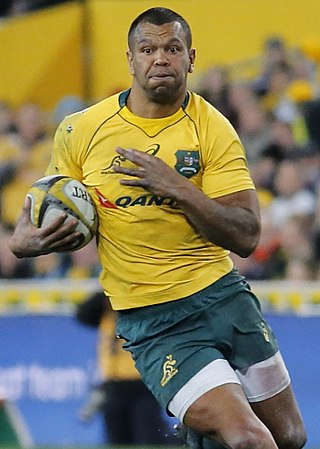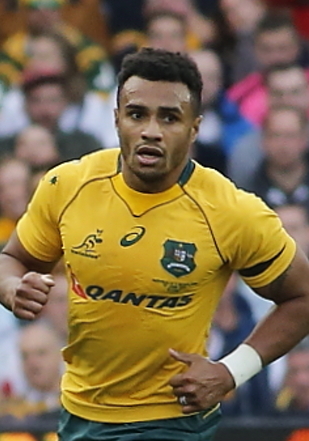Related Research Articles

The Australia national rugby union team, nicknamed the Wallabies, is the representative national team in the sport of rugby union for the nation of Australia. The team first played at Sydney in 1899, winning their first test match against the touring British Isles team.

Berrick Steven Barnes is a former Australian professional rugby union footballer. His usual position is fly-half or inside centre. He is previously played with Japanese Top League clubs Panasonic Wild Knights and the Ricoh Black Rams, as well as in the Super Rugby competition with the NSW Waratahs and Queensland Reds. He also played for the Wallabies in international matches.
Kenneth William Catchpole was an Australian rugby union footballer. A state and national representative half-back, he played twenty-seven matches for Australia, thirteen as captain. Catchpole rose through the ranks at the Randwick club as a young man, before making his debut for New South Wales at only 19 years of age, then captaining Australia at age 21. He is considered one of Australia's greatest rugby scrumhalves.

Christopher Hobart McKivat was an Australian rugby union and rugby league player – a dual-code rugby international. He represented the Wallabies in over 20 Tests and tour matches from 1907 to 1909 and the Kangaroos in 5 Tests from 1910 to 1912. He is unique in Australian rugby history as the only man to captain both the national rugby union and rugby league teams. Following his playing career he became the most successful coach of North Sydney in the club's history.

Kurtley James Beale is an Australian professional rugby union representative player who has made over 90 national representative appearances in a ten-year playing career at the world-class level. He is of Aboriginal descent, has had a long Super Rugby career with the New South Wales Waratahs and has played for the Melbourne Rebels and the Wasps club in England. Beale usually plays at full-back or centre but can play fly-half or winger. In 2011 Beale received the John Eales Medal, awarded to Australian rugby's Player of the Year.
Ewen James Andrew McKenzie is an Australian professional rugby union coach and a former international rugby player. He played for Australia's World Cup winning team in 1991 and earned 51 caps for the Wallabies during his test career. McKenzie was head coach of the Australian team from 2013 to 2014. He has coached in both southern and northern hemispheres, in Super Rugby for the Waratahs and Reds, and in France at Top 14 side Stade Français. During his playing days he was a prop and, in a representative career spanning from 1987 to 1997, he played nine seasons for the NSW Waratahs and two for the ACT Brumbies.

Sanchez William Genia is a professional rugby union player, currently playing scrum-half for the Kintetsu Liners in Japan. He had previously played Super Rugby for the Queensland Reds (2007–2015) and Melbourne Rebels (2018–2019). He also had previously played for Stade Français in France's Top 14 from 2015 to 2017.
Alan Stewart Cameron was an Australian rugby union footballer of the 1950s and 60s. A State and national representative lock-forward he made twenty Test appearances and over fifty additional tour match appearances for the Wallabies, captaining the national side in four Tests matches.

Peter Harold Boyne Burge was an Australian rugby footballer and coach. He represented his country in both rugby league and rugby union. The eldest of the four Burge brothers, Peter was one of the first Australian dual-code rugby internationals.

Arthur Cooper "Johnnie" Wallace was an Australian rugby union player, a state and national representative three-quarter who captained the Waratahs on 25 occasions in the 1920s as well as representing Scotland early in his career.
Between July 1947 and March 1948 the Australia national rugby union team – the Wallabies – conducted a world tour encompassing Ceylon, Britain, Ireland, France and the United States on which they played five Tests and thirty-six minor tour matches. It was the first such tour in twenty years, since that of the 1927–28 Waratahs, as the 1939–40 Australia rugby union tour of Britain and Ireland tour had been thwarted by World War II. They were known as the Third Wallabies.
Colin "Col" Windon, was a rugby union player and soldier who captained Australia – the Wallabies – in two Test matches in 1951. By age 18 Windon was playing at flanker for his club Randwick in Sydney's Shute Shield. After serving with the Second Australian Imperial Force in the Pacific Theatre during the Second World War, Windon resumed his rugby career in 1946. He was first selected for Australia for their tour of New Zealand that year. Despite the Wallabies losing both their Tests on tour, Windon impressed with his play.
Between October 1966 and March 1967 the Australia national rugby union team – the Wallabies – conducted a world tour on which they played five Tests and thirty-one minor tour matches. Under the captaincy of John Thornett they toured UK, Ireland, France and Canada winning nineteen matches, losing fourteen and drawing three. At one stage they failed to win in four successive matches although in the Test match against England they gave the home side its heaviest defeat in 16 years. The tour marked the climax of the successful "Thornett Era" of Australian Rugby, buoyed by the leadership skills of skipper John Thornett and the outstanding abilities of greats of the game like Ken Catchpole, Peter Johnson and Rob Heming. Dick Marks and Peter Crittle also toured and would later become among the most influential administrators of Australian rugby.
David Stewart Rathie is a former Australian sportsperson who represented the Wallabies in rugby union and played first-class cricket with both Queensland in the Sheffield Shield and Canterbury in the Shell Trophy.
Stan Wickham was a pioneer Australian rugby union player, a state and national representative centre who captained the Australian national side on a number of occasions in the early 1900s. He was tour captain for the inaugural Wallaby overseas tour, that to New Zealand in 1905.
The 1912 Australia rugby union tour of Canada and the United States was a collection of friendly rugby union games undertaken by the Australia national rugby union team against various invitational teams from Canada and the U.S, and also against the US national team.
Gregory Victor Davis was a New Zealand born, national representative rugby union player for Australia. He played at flanker and made seven international tours with Wallaby squads. He was the Australian national captain in 47 matches from 1969 to 1972 and led the Wallaby side on three overseas tours.

Peter George Johnson was an Australian international rugby union player. He enjoyed a long state and international career throughout the 1960s and made 92 national appearances for his country. He captained the Australian side in five Test matches.
Geoffrey Arnold Shaw is an Australian former national representative rugby union player who played for and captained the Wallabies. He made state representative appearances for both New South Wales and Queensland over an eleven-year period from 1969.
Edward Stewart Boyce is an Australian former rugby union international.
References
- ↑ "James Stewart Boyce". classicwallabies.com.au.
- ↑ "Reluctantly they clash". The Sydney Morning Herald . 21 July 1965.
- ↑ "The long shadow of racism in Australian sporting history". NITV . SBS. 12 April 2018.